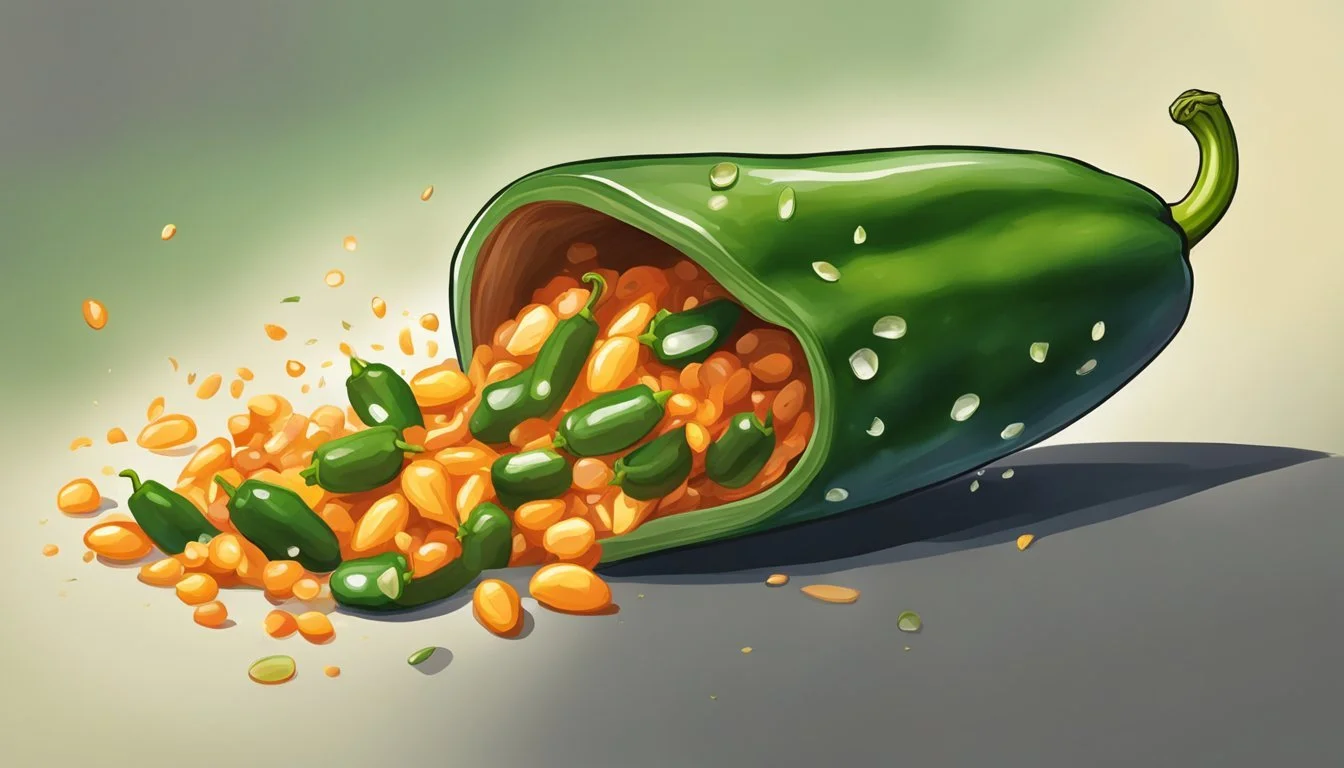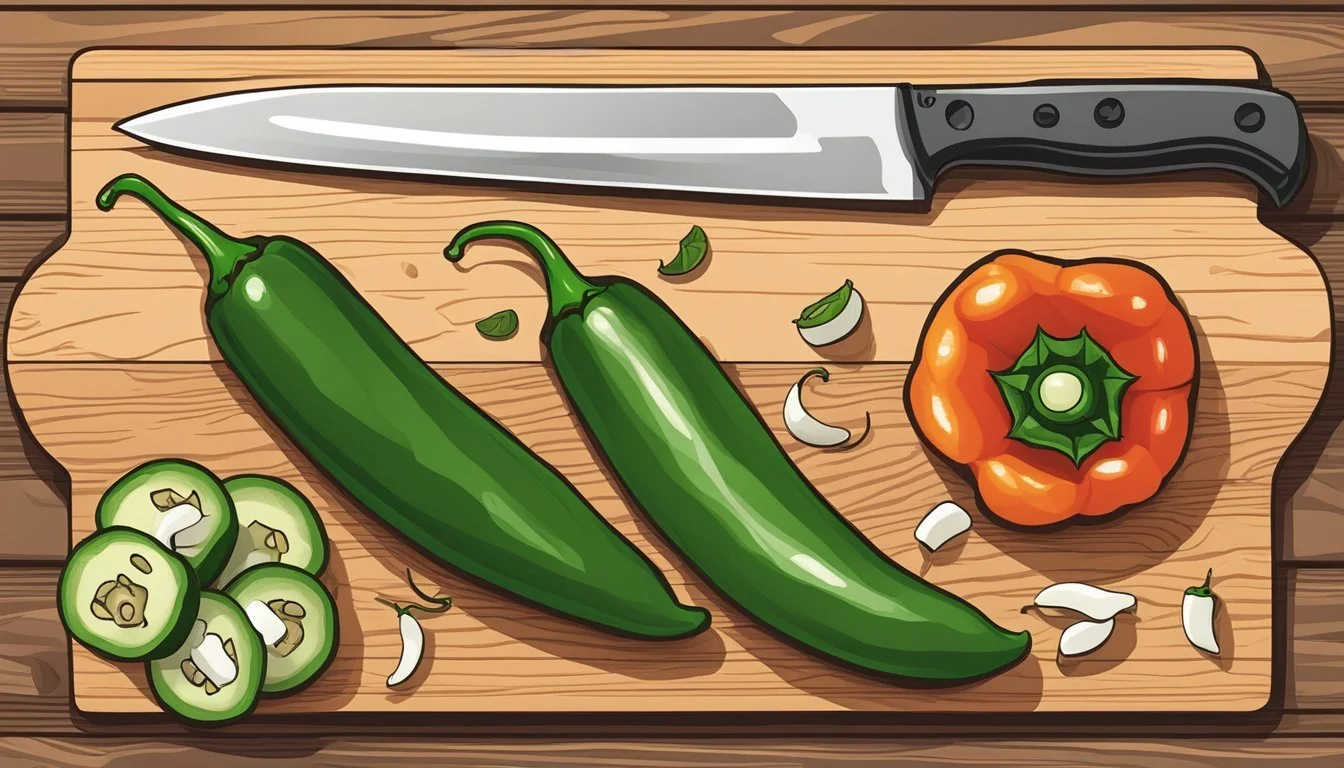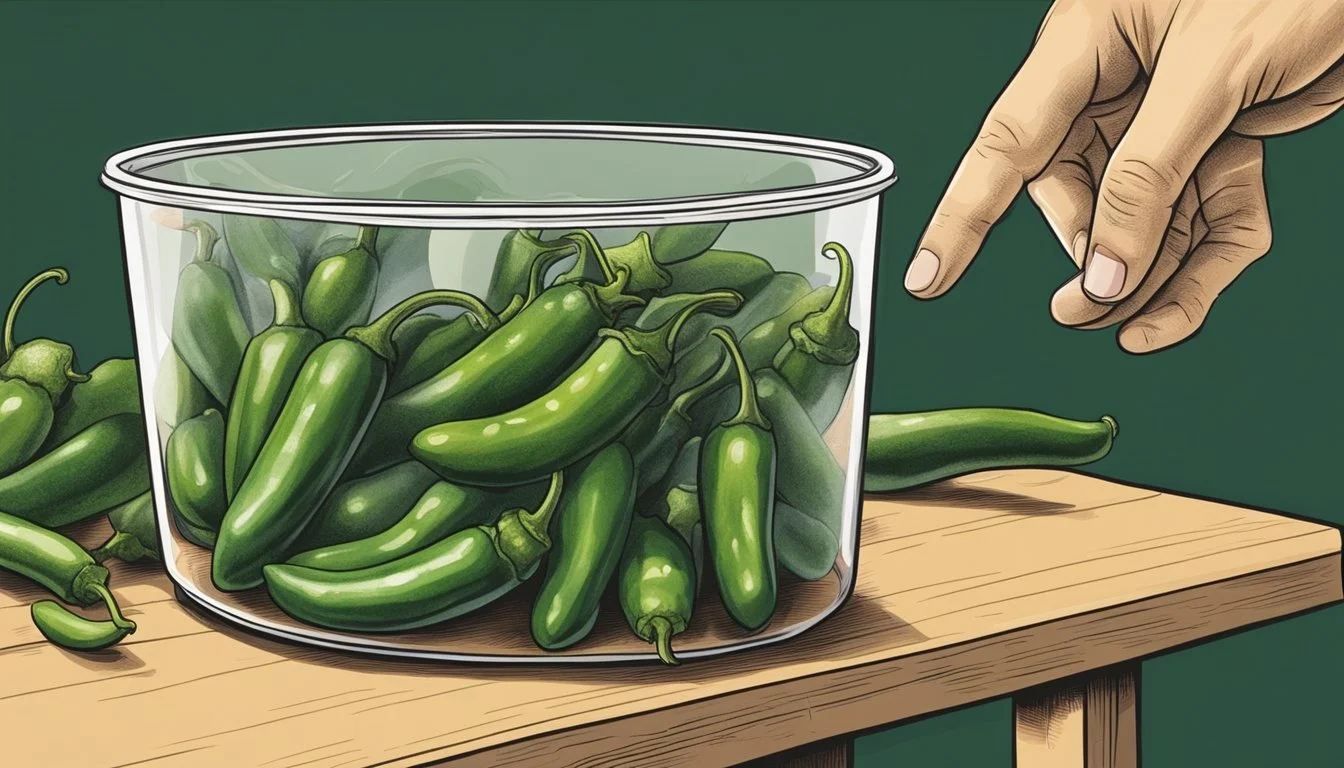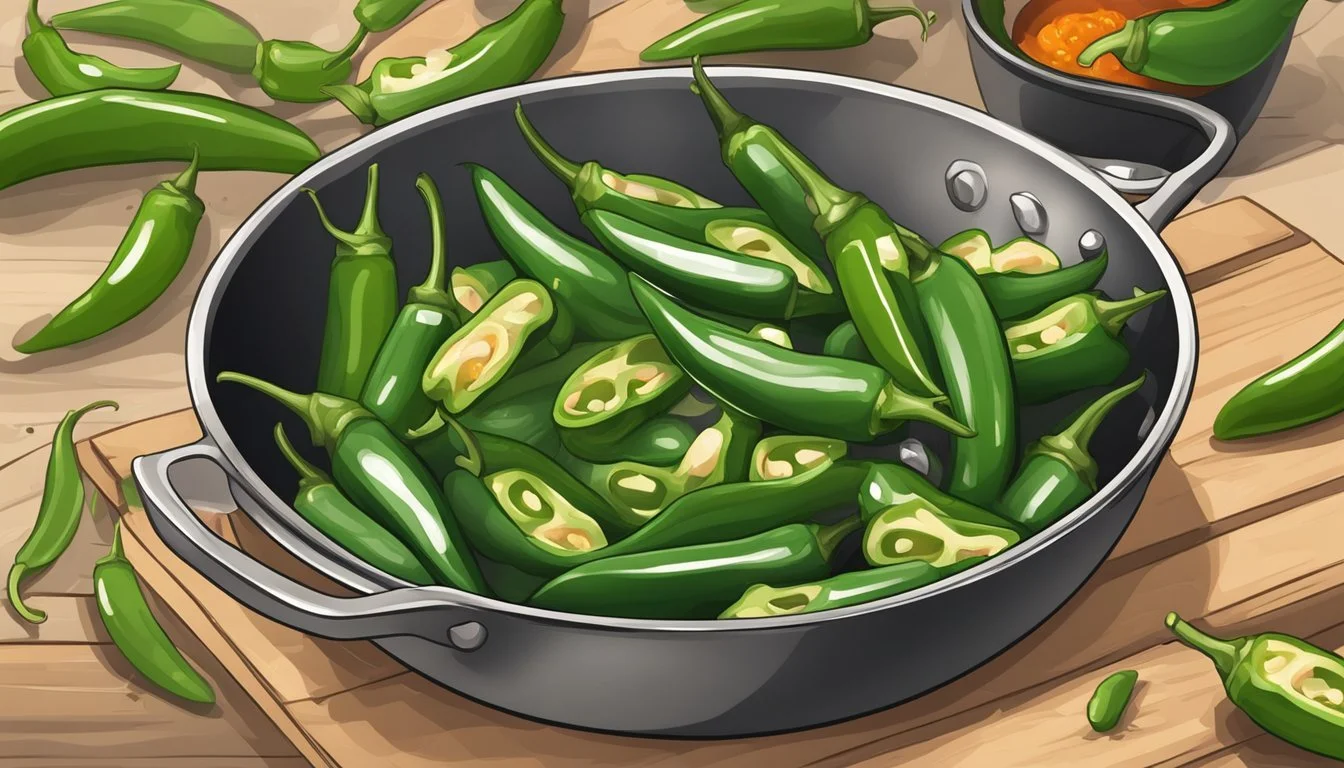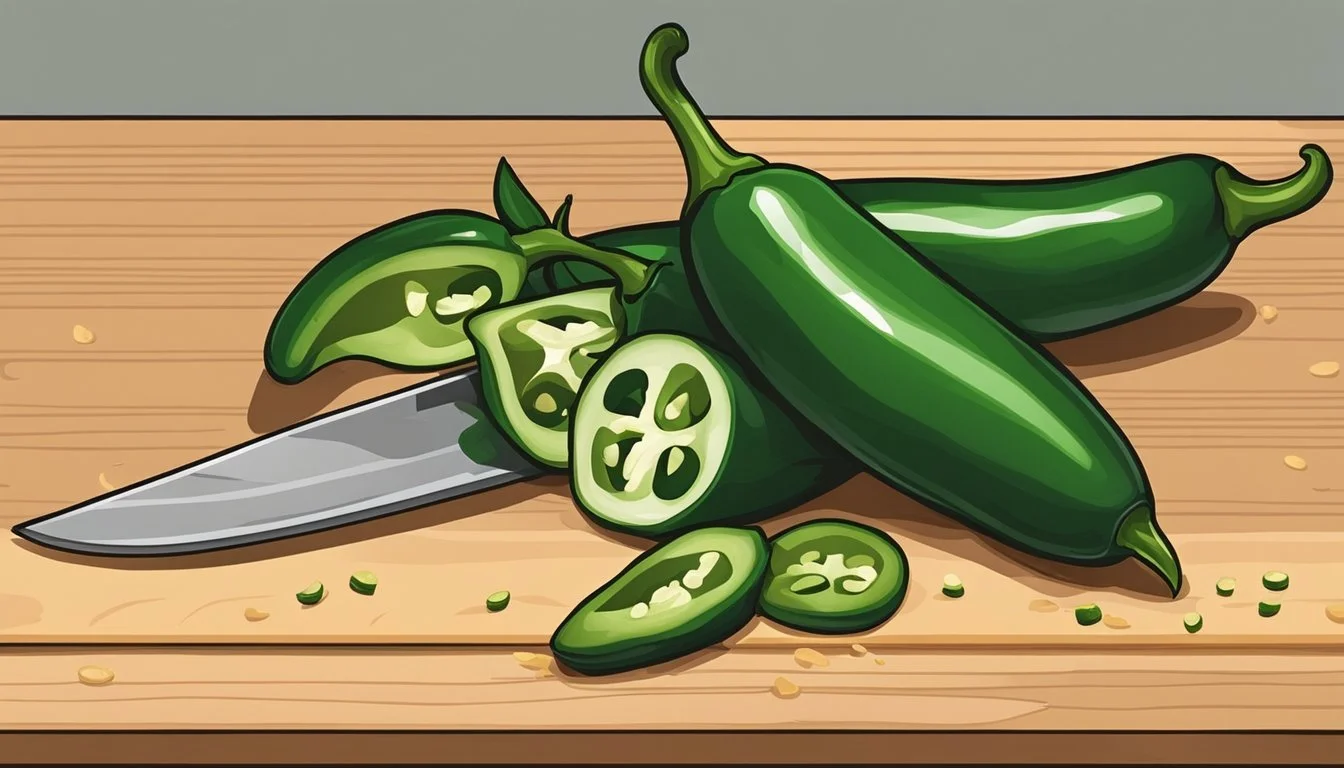How do You Eat a Jalapeño:
A Simple Guide to Enjoying This Spicy Pepper
Eating a jalapeño can be a flavorful and spicy addition to a variety of dishes. Known for their moderate heat and distinctive taste, jalapeños are a type of chili pepper frequently used in Mexican and Tex-Mex cuisines. They provide a balanced combination of heat and flavor that can enhance the overall taste of a meal. When including jalapeños in dishes, one can consider both the desired level of spiciness and the method of preparation to best suit the palate.
Before one eats a jalapeño, it is important to know how to handle this pepper to achieve the intended culinary experience. Removing the seeds and membranes from the jalapeños can significantly reduce their heat, making them more palatable for those who prefer a milder taste. Conversely, leaving these parts intact will retain their natural spiciness. Jalapeños can be consumed raw, pickled, or cooked, with each method yielding a different flavor profile and texture. They can be diced into salsas, sliced for garnishes, stuffed with fillings, or roasted to bring out their smoky sweetness.
When incorporating jalapeños into a diet, one not only adds a burst of flavor but also gains nutritional benefits. Jalapeños are low in calories and rich in vitamins such as vitamin A and C, along with potassium. Additionally, the capsaicin that gives jalapeños their signature heat may offer health benefits such as improved digestion and metabolism. Whether adding a kick to tacos, spicing up a homemade salsa, or enjoying them as part of a nutritious plate, jalapeños are versatile peppers that can cater to a wide array of eating preferences.
Understanding Jalapeños
Jalapeños are a type of chili pepper, which is a berry fruit of plants from the genus Capsicum. Originating from Mexico, they are a popular ingredient in Mexican cuisine and are known for their moderate heat level and distinctive sharp flavor.
Capsaicin is the chemical responsible for the spiciness in jalapeños and other chili peppers. This compound is found primarily in the inner membranes of the pepper, which means the heat can be adjusted somewhat by removing these membranes and the seeds they hold.
Heat Level and Color
The heat level of jalapeños can vary, typically measured in Scoville Heat Units (SHU). On average, jalapeños range from 2,500 to 8,000 SHU, placing them at a mild to moderate heat level compared to other hot peppers.
Green Jalapeños: They are usually picked when they're green and have a crisp texture with a bit of a brightness to their taste.
Ripe Jalapeños: If allowed to ripen fully, jalapeños can turn red, becoming sweeter and sometimes hotter.
Varieties of Jalapeños
Over time, many varieties of jalapeños have been developed, each with its own unique qualities relating to size, flavor, and spiciness. Commonly, jalapeños measure 2-4 inches long and about 1-1.5 inches wide.
When consumed, jalapeños can be enjoyed raw, roasted, stuffed, or pickled, offering a versatile range of uses. Despite the spiciness, jalapeños are low in calories and possess nutritional benefits, being high in vitamins and antioxidants. They can be incorporated into dishes to enhance flavor without adding substantial calories, making them a favored choice among those seeking to balance taste and health.
Selecting and Storing Jalapeños
When consuming jalapeño peppers, selecting fresh peppers and employing proper storage techniques are crucial to ensure both the longevity and the quality of the peppers.
Choosing the Right Jalapeño
One should select jalapeño peppers based on their intended use and flavor preference. In the produce section, look for jalapeños that have firm, glossy skins without any blemishes or soft spots. The color can range from bright green to red; green jalapeños are less ripe and typically less spicy, while red ones are more ripe and slightly sweeter. Smaller jalapeños tend to be spicier than larger ones. A checkered pattern of small white lines or flecks, called 'corking,' can indicate a pepper that has experienced more stress, potentially resulting in more heat.
Proper Storage Techniques
Whole, Fresh Jalapeños:
At Room Temperature: They stay fresh for a few days if kept in a cool, dry place.
In the Refrigerator: Placing whole jalapeños in a plastic bag in the crisper drawer of the fridge can extend their freshness up to a week or more.
Cut or Sliced Jalapeños:
Refrigeration: Store sliced jalapeños in an airtight container in the refrigerator for up to a week.
Freezing: One can freeze sliced jalapeños, but they should be used for cooked dishes as freezing can alter their texture.
Pickled Jalapeños: For longer shelf life, jalapeño peppers can be pickled. Submerge the sliced peppers in a mixture of vinegar, water, sugar, and salt, and seal them in jars. Stored in the fridge, pickled jalapeños can last for several months.
Handling and Preparing Jalapeños
When handling and preparing jalapeños, it is essential to ensure proper hygiene and take safety precautions to avoid irritation. This involves steps such as washing, cutting, and wearing protective gloves.
Washing and Cutting
Before slicing into a jalapeño, one must thoroughly wash the pepper to remove any dirt or contaminants that may be on the skin. To reduce the heat of the jalapeño, a cook should remove the seeds and the white inner membrane, as these parts contain the highest concentration of capsaicin, the compound that gives peppers their spicy heat. They should slice the jalapeño lengthwise and use a spoon or a knife to carefully scrape away these components.
Steps for Cutting Jalapeños:
Wash: Rinse the jalapeño under cold running water.
Slice: Cut off the stem and then halve the jalapeño lengthwise.
Remove Seeds: Gently scrape out the seeds and membrane with a spoon or knife.
Safety Precautions
It is advisable to wear gloves while handling jalapeños to prevent the capsaicin from coming into contact with the skin, which can cause a burning sensation. In case the hands become contaminated and touch sensitive areas like the eyes, it can lead to discomfort or pain. If not using gloves, individuals should wash their hands immediately with soap and water after handling jalapeños to avoid spreading the capsaicin to other surfaces or parts of the body.
Safety Tips:
Wear Gloves: Don protective gloves to prevent skin irritation.
Avoid Touching Eyes: Ensure hands are clean if they must come into contact with the face or eyes.
Clean Surfaces: After cutting jalapeños, clean any surfaces to prevent cross-contamination.
Cooking with Jalapeños
Cooking with jalapeños can enhance the flavor profile of a dish and provide a customizable level of heat. Whether incorporating them into traditional recipes or experimenting with heat control, understanding the use of jalapeños is key in many culinary endeavors.
Incorporating into Recipes
Jalapeños are a versatile ingredient in Mexican cuisine and beyond. They can be diced and added to salsas for a fresh, spicy kick, or sliced to garnish tacos and other dishes. When using jalapeños, one should consider the flavor balance; they should complement other ingredients without overwhelming them. For cooked dishes, adding jalapeños during the cooking process can mellow their heat and allow their flavor to meld with other components.
Raw: Add finely chopped jalapeños to salsas or as garnishes.
Cooked: Incorporate into sautés, soups, and sauces.
Roasted: Roast in the oven or on the grill for a deeper, smoky flavor.
Mastering Heat Control
The heat level of a jalapeño pepper can be adjusted according to individual preference. The seeds and membranes inside the pepper contain capsaicin, the compound responsible for the heat. Removing these can reduce the spiciness. One effective method is to slice the jalapeños in half and scrape out the seeds and membranes with a spoon.
Grilling or roasting jalapeños can not only alter their flavor profile by adding a charred and smoky taste but can also decrease their heat. Controlled exposure to high heat, either in an oven or on a grill, breaks down capsaicin, taming the pepper's spiciness.
Seeds and Membranes: Remove to reduce heat.
Method of Cooking:
Oven Roasting: Enhances flavor and reduces heat.
Grilling: Imparts smokiness and mellows spiciness.
Serving Ideas and Pairings
Jalapeños are versatile, often enhancing dishes with their robust heat and bright flavor. By pairing them carefully, one can elevate a variety of meals, from simple snacks to complex entrees.
Complementary Foods
Salsas and Dips:
Salsa Verde: Jalapeños blend seamlessly into salsa verde, which typically combines green tomatillos with cilantro (how long does cilantro last?), lime juice, and onion for a tangy and spicy dip.
Guacamole: To add a bit of heat to guacamole, dice jalapeños finely and mix them with mashed avocados, cilantro, and onion.
Proteins:
Fish: Jalapeños can be sliced and served atop grilled or baked fish, complementing the protein's mild nature.
Tacos: Incorporate sliced or diced jalapeños into various taco fillings to imbue them with a spicy kick.
Cheeses:
Cream Cheese: (how long does cream cheese last?) Stuffing jalapeños with cream cheese tempers their heat and makes a creamy, indulgent appetizer.
Cheese: Sprinkling chopped jalapeños over dishes like macaroni and cheese brings a spicy contrast to the rich, comforting flavor.
Creating Balanced Flavors
Acidity and Sweetness:
Vinegar: Pickling jalapeños in a vinegar-based brine can soften their heat and add a bright, acidic flavor that complements rich and savory dishes.
Bell Peppers and Onion: Mixing sweet bell peppers and onion with jalapeños can create a pleasant balance of sweetness and heat in salsas and stir-fries.
Herbs and Creaminess:
Cilantro: The herbaceous notes of cilantro can enhance the fresh, green aspect of jalapeños in salsas and guacamole.
Rice and Cheese: Combining jalapeños with rice or melting cheese onto them can mellow out their spiciness, allowing for a gentler palate experience.
Health and Nutrition
Jalapeños offer a rich array of nutrients and health benefits while being low in calories, making them a beneficial addition to one's diet.
Benefits
Jalapeños are a potent source of several key vitamins and nutrients. They are particularly high in Vitamin C and Vitamin A, which are crucial for immune function, skin health, and vision. These peppers contain capsaicin, a compound that may act as a metabolism booster and pain reliever. Furthermore, jalapeños provide Vitamin K, Vitamin E, and B vitamins including folate. Consuming jalapeños can aid in weight loss efforts due to their low caloric content and potential effect on metabolism. The fiber in jalapeños promotes digestive health.
Vitamin C: One raw jalapeño pepper contains about 18.5% of the daily value for this vitamin.
Capsaicin: This component can promote weight loss and offer pain relief.
Vitamin A: Important for skin and eye health.
Vitamin K, Vitamin E, and folate: Essential for various body functions including blood clotting and cell growth.
Considerations
While jalapeños offer numerous health benefits, individuals should be aware of some considerations. The capsaicin in jalapeños, which provides pain relief, can also cause heartburn or irritate irritable bowel syndrome in some people. Due to their spicy nature, they can trigger digestive discomfort if consumed in large quantities. Jalapeños can be a source of antioxidants which help protect cells from damage, but overconsumption may lead to adverse effects.
Capsaicin: Could lead to heartburn or exacerbate symptoms of irritable bowel syndrome in sensitive individuals.
Antioxidants: Help fight damage to cells but should be consumed in moderation.
Preservation Methods
When looking to extend the shelf life of jalapeños, one can employ various preservation methods. Each technique is tailored to enhance longevity and maintain the potent flavor of the peppers. Proper preservation ensures that jalapeños are available for culinary use well beyond their typical fresh lifespan.
Refrigeration
In the refrigerator, jalapeños can last for about a week. They should be stored in the crisper drawer, preferably wrapped in paper towels to absorb any excess moisture. For optimal storage, one might place the peppers in an airtight container or a resealable plastic bag, which can help retain their crisp texture and pungent taste.
Freezing
Freezing jalapeños is a straightforward preservation method. Firstly, the peppers should be thoroughly rinsed and dried. One can then slice or dice the jalapeños as desired and arrange them on a baking sheet lined with parchment paper to prevent sticking. After freezing them individually, transfer the peppers into a freezer bag or container, which keeps them conveniently usable for future recipes. Frozen jalapeños can last several months.
Pickling
For homemade pickled jalapeños, one requires a clean jar, fresh jalapeños, a boiling mixture of vinegar, water, and spices such as a garlic clove for additional flavor. After packing the peppers into jars, one pours the hot pickling brine over them, ensuring they are fully covered. Sealing the jars tightly and processing them in a water bath canner will create an environment that preserves the peppers. Pickled jalapeños can be stored in a cool, dark place for an extended period before opening and should be refrigerated once opened.
Troubleshooting Common Issues
When consuming jalapeños, individuals may encounter issues such as excessive spiciness or spoilage. These can detract from the enjoyment and benefits of the peppers. The following subsections provide effective strategies for mitigating these concerns.
Reducing Excessive Heat
Jalapeños contain capsaicin, which is responsible for their heat. To reduce the spiciness, one can employ several methods:
Dairy: Incorporating dairy products such as milk, sour cream, or yogurt can counteract the heat as dairy contains casein, a substance that binds with capsaicin and helps to wash it away.
Acid and Sugar: Adding acidic ingredients like lemon juice or vinegar, along with a touch of sugar, can mitigate the pepper's heat and balance the flavors.
Fats: Consuming jalapeños with fatty foods can also help, as capsaicin is soluble in fat, which can lessen the burning sensation.
These methods do not remove capsaicin but rather minimize its impact on the palate.
Dealing with Spoilage
Jalapeños, like all fresh produce, are prone to spoilage. Recognizing and preventing spoilage ensures safety and quality:
Visual Inspection: Look for jalapeños that are firm with a bright, consistent color and glossy skin. Avoid those with soft spots, wrinkles, or mold.
Storage: Proper storage is key. Jalapeños should be stored in the refrigerator in a plastic bag, which will usually keep them fresh for over a week.
Freezing: For long-term storage, consider freezing. Jalapeños can be frozen whole, sliced, or diced and used later in cooked dishes.
Heartburn Caution: Spoiled peppers may increase the risk of heartburn or gastrointestinal discomfort. Disposing of any jalapeños that show signs of spoilage is crucial for health.
Innovative Jalapeño Applications
Jalapeño peppers are versatile ingredients that can transform a variety of dishes with their spicy kick. They are not only used in traditional cuisine but also in groundbreaking gastronomic experiments.
Fusion Dishes
In fusion cuisine, chefs creatively blend culinary traditions, and jalapeños are stars in this arena. For instance:
Asian-Mexican recipes might feature jalapeño peppers as a spicy twist to the classic stir-fry, introducing a piquant note alongside more mellow vegetables such as bell peppers.
In Italian-Mexican crossover, one might find pasta dishes graced with diced jalapeño peppers, marrying them with creamy sauces and offsetting richer flavors with their brightness.
American Southwest cooking, with its love for the heat, often features jalapeños in combination with Anaheim peppers to create a nuanced chile experience, especially notable in salsa verde.
Experimental Flavor Combinations
Innovative flavor combinations push the boundaries of traditional taste profiles:
Salsa Variations: Jalapeño peppers are a staple in salsas, but contemporary takes might include fruits like mango or pineapple for a sweet and spicy fusion.
Sweet Heat Creations: Candied jalapeños can add an unexpected twist to desserts and drinks, offering a juxtaposition of sugar and spice that can be especially intriguing in cocktail recipes.
Incorporating jalapeños with milder peppers, such as green peppers, can balance out the heat while retaining the signature jalapeño flavor.
Pickling Experiments: Creating pickles with a mix of jalapeño and serrano peppers results in a condiment with multi-layered heat that can elevate a simple dish to something special.
Resources and Inspiration
When seeking to integrate jalapeños into one's diet, culinary websites and forums, along with the guidance of esteemed cookbooks and chefs, provide a wealth of resources. These sources offer a myriad of ways to incorporate jalapeños into fresh salsa, hot sauces, and a variety of recipes to satiate one's spicy cravings.
Culinary Websites and Forums
Culinary experts and enthusiasts alike frequently share their insights on platforms like Pinterest and various food forums. Pinterest is particularly abundant with recipe inspiration, including creative ideas for jalapeño-infused dishes. Forums also serve as a trove of advice where one can learn the nuances of working with jalapeños, from managing their heat to pairing them with complementary ingredients.
Online Resources for Jalapeño Recipes and Inspiration:
Pinterest: Sensational jalapeño recipes, ranging from appetizers to entrees
Food Forums: Discussions on the best practices for incorporating jalapeños into sauces and dishes
Cookbooks and Chefs
Renowned chefs often publish cookbooks that delve into the use of jalapeños in both traditional and innovative ways. These chefs demystify the process of preparing fresh salsa, designing hot sauces, and infusing jalapeños into a myriad of recipes. Cookbooks dedicated to spicy cuisine can be especially helpful for enthusiasts looking to elevate their cooking with jalapeños.
Notable Chefs and Cookbooks:
Chef John's Fiery Flavors: A guide to homemade hot sauces and zesty recipes
The Spicy Food Lovers' Cookbook: Techniques and recipes for making perfect fresh salsa and bold sauces

